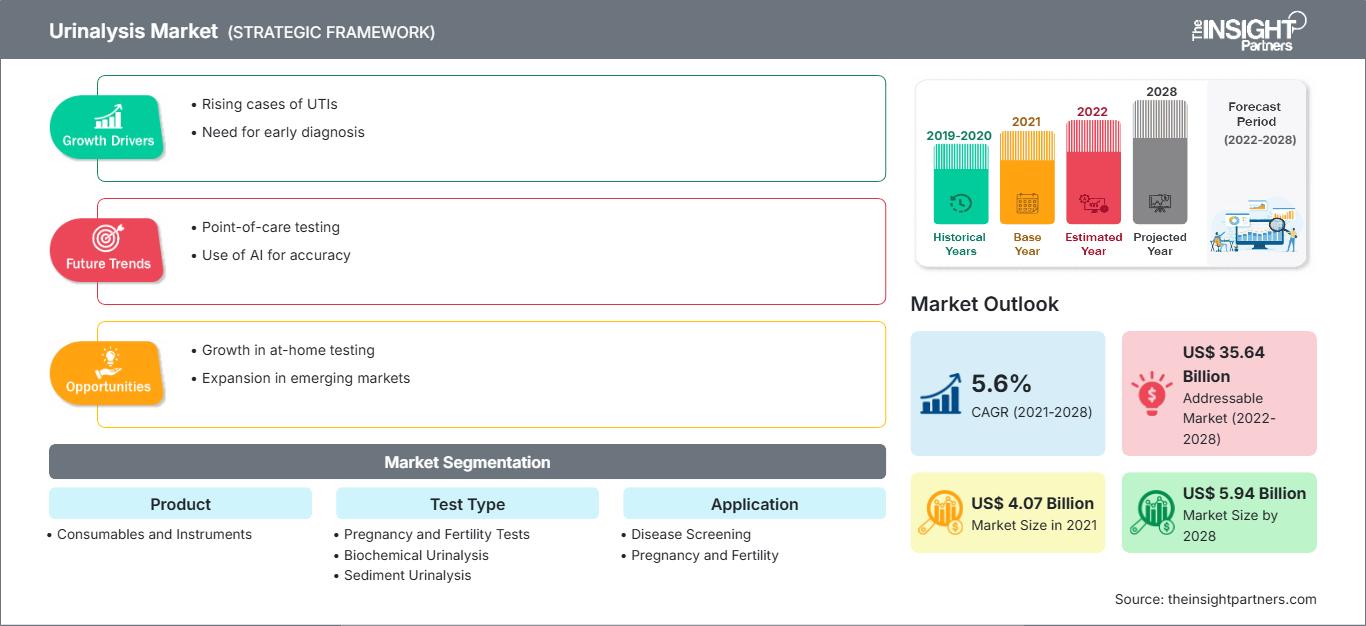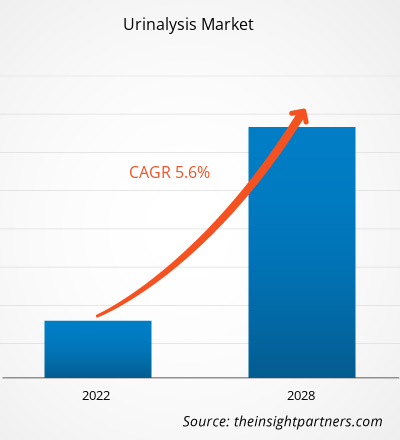Si prevede che il mercato dell'analisi delle urine raggiungerà i 5.937,97 milioni di dollari entro il 2028, rispetto ai 4.065,79 milioni di dollari del 2021; si prevede una crescita a un CAGR del 5,6% dal 2021 al 2028.
L'analisi delle urine viene utilizzata nella diagnosi e nella gestione di vari disturbi come malattie renali, infezioni del tratto urinario e diabete. Si tratta dell'analisi delle urine mediante metodi chimici, fisici e microscopici per verificare la presenza di farmaci e sostanze correlate alla malattia, comprese biomolecole o altri sottoprodotti. L'analisi delle urine include il controllo della concentrazione, dell'aspetto e del contenuto delle urine. Nell'analisi delle urine, risultati anomali o stime al di fuori dell'intervallo previsto possono indicare una malattia o un disturbo. Se il risultato del test delle urine è positivo, potrebbe indicare che i reni non funzionano o non filtrano il sangue come dovrebbero. Potrebbe anche aiutare nella diagnosi di malattie cardiovascolari e nel rilevamento di gravidanza e ovulazione.
Il mercato dell'analisi delle urine è stato segmentato in base a prodotto, tipo di test, applicazione, utente finale e area geografica. In base all'area geografica, il mercato è principalmente suddiviso in Nord America, Europa, Asia-Pacifico, Medio Oriente e Africa, e Sud e Centro America. Il rapporto offre approfondimenti e analisi approfondite del mercato dell'analisi delle urine, evidenziando parametri quali tendenze di mercato, progressi tecnologici e dinamiche di mercato, insieme a un'analisi del panorama competitivo dei principali attori del mercato a livello globale.
Personalizza questo rapporto in base alle tue esigenze
Potrai personalizzare gratuitamente qualsiasi rapporto, comprese parti di questo rapporto, o analisi a livello di paese, pacchetto dati Excel, oltre a usufruire di grandi offerte e sconti per start-up e università
Mercato dell'analisi delle urine: Approfondimenti strategici

-
Ottieni le principali tendenze chiave del mercato di questo rapporto.Questo campione GRATUITO includerà l'analisi dei dati, che vanno dalle tendenze di mercato alle stime e alle previsioni.
Approfondimenti di mercato
Il crescente peso delle infezioni del tratto urinario, del diabete e delle malattie renali stimola la crescita del mercato dell'analisi delle urine
Secondo uno studio pubblicato nel 2020 da un gruppo di ricercatori dell'American College of Physicians and Infectious Diseases Society of America, circa 6 milioni di persone negli Stati Uniti si rivolgono ogni anno a un medico per il trattamento delle infezioni del tratto urinario (UTI). Le donne presentano un rischio maggiore di sviluppare infezioni del tratto urinario rispetto agli uomini. Secondo uno studio pubblicato sull'International Journal of Environmental Research and Public Health nel 2019, i pazienti con patologie croniche preesistenti, come il diabete mellito (DM), presentano un rischio maggiore di contrarre infezioni del tratto urinario. La domanda di componenti necessari per l'analisi delle urine è in aumento a causa della comune incidenza del diabete in tutto il mondo, poiché lo screening primario per il diabete prevede l'analisi delle urine. Secondo l'International Diabetes Federation (IDF), nel 2019 circa 463 milioni di adulti (di età compresa tra 20 e 79 anni) nel mondo soffrivano di diabete; è probabile che questo numero salirà a 700 milioni entro il 2045. Secondo l'IDF, nel Sud-est asiatico nel 2019 circa 87,6 milioni di adulti di età compresa tra 20 e 79 anni soffrivano di diabete, con una prevalenza regionale dell'8,8%, e circa il 56,7% di questi casi di diabete non era diagnosticato, il che dimostra il potenziale di sviluppo del mercato dell'analisi delle urine. Inoltre, secondo uno studio pubblicato dalla National Kidney Foundation nel 2020, circa il 35% della popolazione diabetica di età superiore ai 20 anni svilupperebbe malattie renali croniche nel periodo considerato. L'aumento continuo della prevalenza del cancro alla prostata e alla vescica pone un forte imperativo terapeutico per l'implementazione di diagnosi altamente efficaci.
Pertanto, la crescente prevalenza di infezioni delle vie urinarie, diabete e malattie renali stimola la crescita del mercato dell'analisi delle urine.
Approfondimenti basati sui prodotti
In base al prodotto, il mercato dell'analisi delle urine è segmentato in materiali di consumo e strumenti. Si prevede che il segmento dei materiali di consumo detenga una quota di mercato maggiore nel 2021 e si prevede inoltre che registri un CAGR più elevato durante il periodo di previsione.
Approfondimenti basati sul tipo di test
Il mercato dell'analisi delle urine, in base al tipo di test, è segmentato in test di gravidanza e fertilità, analisi biochimica delle urine e analisi del sedimento urinario. Il segmento dell'analisi biochimica delle urine deterrà la quota maggiore del mercato nel 2021 e si stima che registrerà il CAGR più elevato nel periodo 2021-2028.
Approfondimenti basati sulle applicazioni
In base all'applicazione, il mercato dell'analisi delle urine è segmentato in screening delle malattie, gravidanza e fertilità. Il segmento dello screening delle malattie rappresenterà una quota di mercato maggiore nel 2021. Si stima che il mercato per lo stesso segmento crescerà a un CAGR più elevato dal 2021 al 2028.
Approfondimenti basati sull'utente finale
Il mercato dell'analisi delle urine, per utente finale, è segmentato in ospedali e cliniche, laboratori diagnostici, strutture di assistenza domiciliare e laboratori e istituti di ricerca. Il segmento ospedali e cliniche deterrà la quota maggiore del mercato nel 2021, mentre si stima che il segmento dei laboratori diagnostici registrerà il CAGR più elevato durante il periodo di previsione.
Il COVID-19 ha rappresentato l'emergenza sanitaria globale più significativa fino ad oggi. I lockdown causati dalla pandemia di COVID-19 hanno costretto le persone a ritardare le visite di controllo, incidendo così sul numero di test eseguiti e sulle vendite di strumenti, materiali di consumo e reagenti. Il mercato delle analisi delle urine ha registrato un calo all'inizio della crisi COVID-19 a causa dell'interruzione della catena di approvvigionamento e della domanda dovuta al lockdown annunciato dalla maggior parte dei paesi europei. Tuttavia, si osserva una ripresa del numero di test effettuati, con il graduale allentamento delle restrizioni alla circolazione da parte dei paesi.
Acquisizioni, collaborazioni, partnership, lanci di prodotti ed espansioni sono strategie comunemente adottate dalle aziende per espandere la propria presenza a livello mondiale e soddisfare la crescente domanda. Gli operatori del mercato dell'analisi delle urine hanno adottato principalmente la strategia dell'innovazione di prodotto per soddisfare le mutevoli esigenze dei clienti in tutto il mondo, il che li aiuta anche a mantenere il loro marchio a livello globale.
Approfondimenti regionali sul mercato dell'analisi delle urine
Le tendenze e i fattori regionali che hanno influenzato il mercato dell'analisi delle urine durante il periodo di previsione sono stati ampiamente spiegati dagli analisti di The Insight Partners. Questa sezione illustra anche i segmenti e la geografia del mercato dell'analisi delle urine in Nord America, Europa, Asia-Pacifico, Medio Oriente e Africa, America Meridionale e Centrale.
Ambito del rapporto di mercato sull'analisi delle urine
| Attributo del rapporto | Dettagli |
|---|---|
| Dimensioni del mercato in 2021 | US$ 4.07 Billion |
| Dimensioni del mercato per 2028 | US$ 5.94 Billion |
| CAGR globale (2021 - 2028) | 5.6% |
| Dati storici | 2019-2020 |
| Periodo di previsione | 2022-2028 |
| Segmenti coperti |
By Prodotto
|
| Regioni e paesi coperti |
Nord America
|
| Leader di mercato e profili aziendali chiave |
|
Densità degli operatori del mercato dell'analisi delle urine: comprendere il suo impatto sulle dinamiche aziendali
Il mercato dell'analisi delle urine è in rapida crescita, trainato dalla crescente domanda degli utenti finali, dovuta a fattori quali l'evoluzione delle preferenze dei consumatori, i progressi tecnologici e una maggiore consapevolezza dei benefici del prodotto. Con l'aumento della domanda, le aziende stanno ampliando la propria offerta, innovando per soddisfare le esigenze dei consumatori e sfruttando le tendenze emergenti, alimentando ulteriormente la crescita del mercato.

- Ottieni il Mercato dell'analisi delle urine Panoramica dei principali attori chiave
Profili aziendali
- Abbott
- ACON Laboratories, Inc.
- ARKRAY, Inc.
- Beckman Coulter, Inc.
- Bio-Rad Laboratories Inc.
- Cardinal Health Inc
- F. Hoffmann-La Roche Ltd.
- Quidel Corporation
- Siemens Healthineers AG
- Sysmex Corporation
- Analisi storica (2 anni), anno base, previsione (7 anni) con CAGR
- Analisi PEST e SWOT
- Valore/volume delle dimensioni del mercato - Globale, Regionale, Nazionale
- Industria e panorama competitivo
- Set di dati Excel
Report recenti
Testimonianze
Motivo dell'acquisto
- Processo decisionale informato
- Comprensione delle dinamiche di mercato
- Analisi competitiva
- Analisi dei clienti
- Previsioni di mercato
- Mitigazione del rischio
- Pianificazione strategica
- Giustificazione degli investimenti
- Identificazione dei mercati emergenti
- Miglioramento delle strategie di marketing
- Aumento dell'efficienza operativa
- Allineamento alle tendenze normative






















 Ottieni un campione gratuito per - Mercato dell'analisi delle urine
Ottieni un campione gratuito per - Mercato dell'analisi delle urine